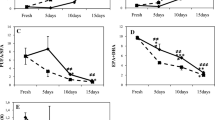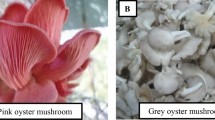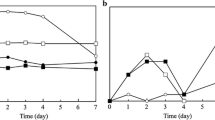Abstract
Wild mussels (Mytilus galloprovincialis), were packaged aerobically under vaccum packaging(VP) and modified atmosphere packaging (MAP (50%/50% CO2/N2: M1, 80%/20% CO2/N2: M2, 65%/35% CO2/N2: M3), and stored at 2 ± 1 °C. Quality evaluation was carried out using microbiological, chemical and sensory analyses. Microbiological results revealed that M2 and M3 delayed microbial growth compared to M1. Of the chemical indices determined, the TVB-N and TMA-N values of M2 remained lower than the proposed acceptability limits of 35 mg N/100 g and 8 mg N/100 g, respectively, up to 8 days of storage. All of the MAP and VP mussel samples exceeded these limits after 12 days of storage. All samples retained desirable sensory characteristics during the first 8 days of storage. Based on microbiological and chemical analyses along with sensory evaluation, M2 and M3 gave a longer shelf-life compared with VP and M1. M2 gas mixture was the most effective for mussel preservation.
Similar content being viewed by others
References
FAO (2003) Fisheries Statistics. Food and Agriculture Organization of the United Nations
Anonym (2002) Fisheries Statistics. State Institute of Statistics, Prime Ministry Republic of Turkey, Ankara
Vareltzis K (1996) Mussels as food. Fish News 11:38–47
Orban E, Di Lena G, Nevigato T, Casini I, Marzetti A, Caproni R (2002) Seasonal changes in meat content, condition index and chemical composition of mussels (Mytilus galloprovincialis) cultured in two different Italian sites. Food Chem 77:57–65
Kromhout D, Bosschieter EB, Lezenne CC (1985) The inverse relationship between fish consumption and 20-year mortality from coronary heart disease. N Engl J Med 312:1205–1209
The nutritional value of shellfish. Report of Project A/PC-5 from the National Oceanic and Atmospheric Administration to Washington Sea Grant Program, University of Washington, 2001. http://www.wsg.washington.edu
Goulas AE, Chouliara I, Nessi E, Kontominas MG, Savvaidis IN (2005) Microbiological, biochemical and sensory assessment of mussels (Mytilus galloprovincialis) stored under modified atmosphere packaging. J Appl Microbiol 98:752–760
Reddy NR Amstrong DJ, Rhodehamel EJ, Kauter DA (1992) Shelf-life extension and safety conderns about fresh fishery products packaged under modified atmospheres: a review. J Food Saf 12:87–118
Swiderski F, Russel S, Waszkiewicz-Robak B, Cholewinska E (1997) Evaluation of vacuum-packaged poultry meat and its products. Rocz Panstw Zakl Hig 48:193–200
Young H, MacFie HJH, Light N (1989) Effect of packaging and storage on the sensory quality of cooked chicken menu items served from chilled vending machines. J Sci Food Agric 48:323–338
Goto M, Hashimoto K, Yamada K (1995) Difference of ascorbic acid content among some vegetables, texture in chicken, pork, and sensory evaluation score in some dishes between vacuum and ordinary cooking. Nippon Shokuhin Kagaku Kogaku Kaishi 42:50–54
Juneja VK, Marmer BS, Call JE (1996) Influence of modified atmosphere packaging on growth of Clostridium perfringens in cooked turkey. J Food Saf 16:141–150
Davies AR (1997) Modified-atmosphere packaging of fish and fish products. In: Hall GM (ed) Fish processing technology, 2nd edn. Blackie Academic and Professional, London, pp 200–223
Sivertsvik M, Jeksrud WK, Rosnes JT (2002) A review of modified atmosphere packaging of fish and fishery products—significance of microbial growth activities and safety. Int J Food Sci Technol 37:107–127
Gray RJH, Hoover DG, Muir AM (1983) Attenuation of microbial growth on modified atmosphere—packaged fish. J Food Prot 46:610–613
Cann DC, Houston JC, Smith GL (1985) Studies of shellfish packed and stored under a modified atmosphere. Torry Research Station, Aberdeen
Brody AL (1989) Modified atmosphere packaging of seafoods. In: Brody AL (ed) Controlled/Modified atmosphere/vacuum packaging of foods. Food and Nutrition Press Inc., Connecticut, pp 59–65
Bak LS, Andersen AB, Andersen EM, Bertelsen G (1999) Effect of modified atmosphere packaging on oxidative changes in frozen stored cold water shrimp (Pandalus borealis). Food Chem 64:169–175
Dalgaard P, Jorgensen VL (2000) Cooked and brined shrimps packed in a modified atmosphere have a shelf-life >7 months at 0°C, but spoil in 4–6 days at 25°C. Int J Food Sci Technol 35:431–439
Goto M, Hashimoto K, Yamada K (1995) Difference of ascorbic acid content among some vegetables, texture in chicken, pork, and sensory evaluation score in some dishes between vacuum and ordinary cooking. Nippon Shokuhin Kagaku Kogaku Kaishi 42:50–54
Poli BM, Messini A, Parisi G,Scappini F,Vigiani V, Giorgi G, Vincenzini M (2006) Sensory physical, chemical and microbiological changes in European sea bass (Dicentrarchus labrax) fillets packed under modified atmosphere/air or prepared from whole fish stored in ice. Int J Food Sci Technol 41:444–454
Harrigan WF, McCance ME (1976) Laboratory methods in food and dairy microbiology. Academic, New York
Debevere J, Boskou G (1996) Effect of modified atmosphere packaging on the TVB/TMA producing microflora of cod fillets. Int J Food Microbiol 31:221–229
Lima Dos Santos C, James D, Teutscher F (1981) Guidelines for chilled fish storage experiments FAO Fish Tech Pap, p 210
Vyncke W (1996) Comparison of the official EC method for the determination of total volatile bases in fish with routinemethods. Arch Lebensmittelhyg 47:110–112
Tarladgis BG, Watts BM, Younathan MS, Dugan L Jr (1960) A Distillation method for the quantitative determination of malonaldehyde in rancid foods. J Am Oil Chem Soc 37:44–48
AOAC (1995) Official Methods of Analysis, 14th edn. Association of Official Analytical Chemistry, Washington
Schubring R (2002) Influence of freezing/thawing and frozen storage on the texture and color of brown shrimp (Crangon crangon). Arch Lebensmittelhyg 53(2):34–36
Anonym (1999) Codex guidelines for the sensory evaluation of fish and shellfish in laboratories CAC-GL 31:1–33
Mitsuda H, Nakajima K, Mizuno H, Kawai F (1980) Use of sodium chloride solution and carbon dioxide for extending shelf-life of fish fillets. J Food Sci 45:661–666
ICMSF (1992) International commission on microbiological specifications for foods. Sampling plans for fish and shellfish. In: ICMSF, Microorganisms in Foods. Sampling for Microbiological Analysis: Principles and Scientific Applications (eds) University of Toronto Press, Toronto
Huss (1992) Storage life of prepacked wet fish at 0°C, I plaice and haddock at 0°C. J Food Technol 7:13–19
Molin G, Stenstrom IM, Ternstrom A (1983) The chemical flora of herring fillets after storage in carbon dioxide, nitrogen or air at 2°C. J Appl Bacteriol 55:49–56
Pelroy GA, Eklund MW, Paranjpye RN, Suzuki EM, Peterson ME (1982) Inhibition of Clostridium botulinum types A and E toxin formation by sodium nitrite and sodium chloride in hotprocess (smoked) salmon. J Food Prot 45(9):833–841
Crandall AD, Montville TJ (1993) Inhibition of Cl. Botulinum growth and toxinogenesis in a model gravy system by coinoculation with bacteriocin producing lactic acid bacteria. J Food Prot 56:485–488
Gonzalez RMN, Sanz JJ, Santos JA, Otero A, Garcia-Lopez ML (2002) Numbers and types of microorganisms in vacuum–packed cold smoked fresh water fish at the retail level. Int J Food Microbiol 77(1–2):161–168
EEC (1995) Total volatile basic nitrogen (TVB-N) limit values for certain categories of fishery products and specifying the analysis methods to be used. Commission Decision 95/149/EEC of 8 March 1995, Official J Euro Communities L 97:84–87
Connell JJ (1990) Methods of assessing and selecting for quality. In: Connell JJ (ed) Control of fish quality 3rd edn. Fishing News Books, Oxford pp 122–150
Lopez-Caballero ME, Perez-Mateos M, Montero P, Borderias AJ (2000) Oyster preservation by high-pressure treatment. J Food Prot 63:196–201
Pastoriza L, Bernardez M, Sampedro G, Gabo ML, Herrera JJR (2004) Elevated concentrations of oxygen on the stability of live mussel stored refrigerated. Euro Food Res Technol 218:415–419
Erkan N (2005) Changes in quality characteristics during cold storage of shucked mussels (Mytilus galloprovincialis) and selected chemical decomposition indicators. J Sci Food Agric 85:2625–2630
Curzio OA, Quaranta HO (1982) Delay of oxidative rancidity in irradiated hake (Merluccius merluccius hubbsi). Lebenson Wiss Technol 15:171–172
Chouliara I, Savvaidis IN, Panagiotakis N, Kontominas MG (2004) Preservation of salted, vacuum-packaged, refrigerated sea bream (Sparus aurata) fillets by irradiation: microbiological, chemical and sensory attributes. Food Microbiol 21:351–359
Schormuller J (1969) Handbuch der Lebensmittel Chemie, Band IV, Fette und Lipoide (Lipids), Springer, Berlin, pp 872–878
Aaraas R, Hernar IJ, Vorre A, Bergslien H, Lunestad BT, Skeie S, Slinde E, Mortensen S (2004) Sensory, histological and bacteriological changes in flat oysters, Ostrea edulis L.,during different storage conditions. J Food Sci 69:205–210
Thomas D, Avery MW, Phleger CF (1991) Chilled (5°C) and frozen (–18°C) storage stability of the purple-high rock scallop, Hinnites multirugosus Gale. J Food Sci 47:1654–1661
Hardy D (1991) Handling, processing and marketing scallop farming. Fishing News Books, Osney Meat, Oxford, pp 168–180
Author information
Authors and Affiliations
Corresponding author
Rights and permissions
About this article
Cite this article
Caglak, E., Cakli, S. & Kilinc, B. Microbiological, chemical and sensory assessment of mussels (Mytilus galloprovincialis) stored under modified atmosphere packaging. Eur Food Res Technol 226, 1293–1299 (2008). https://doi.org/10.1007/s00217-007-0657-1
Received:
Revised:
Accepted:
Published:
Issue Date:
DOI: https://doi.org/10.1007/s00217-007-0657-1




